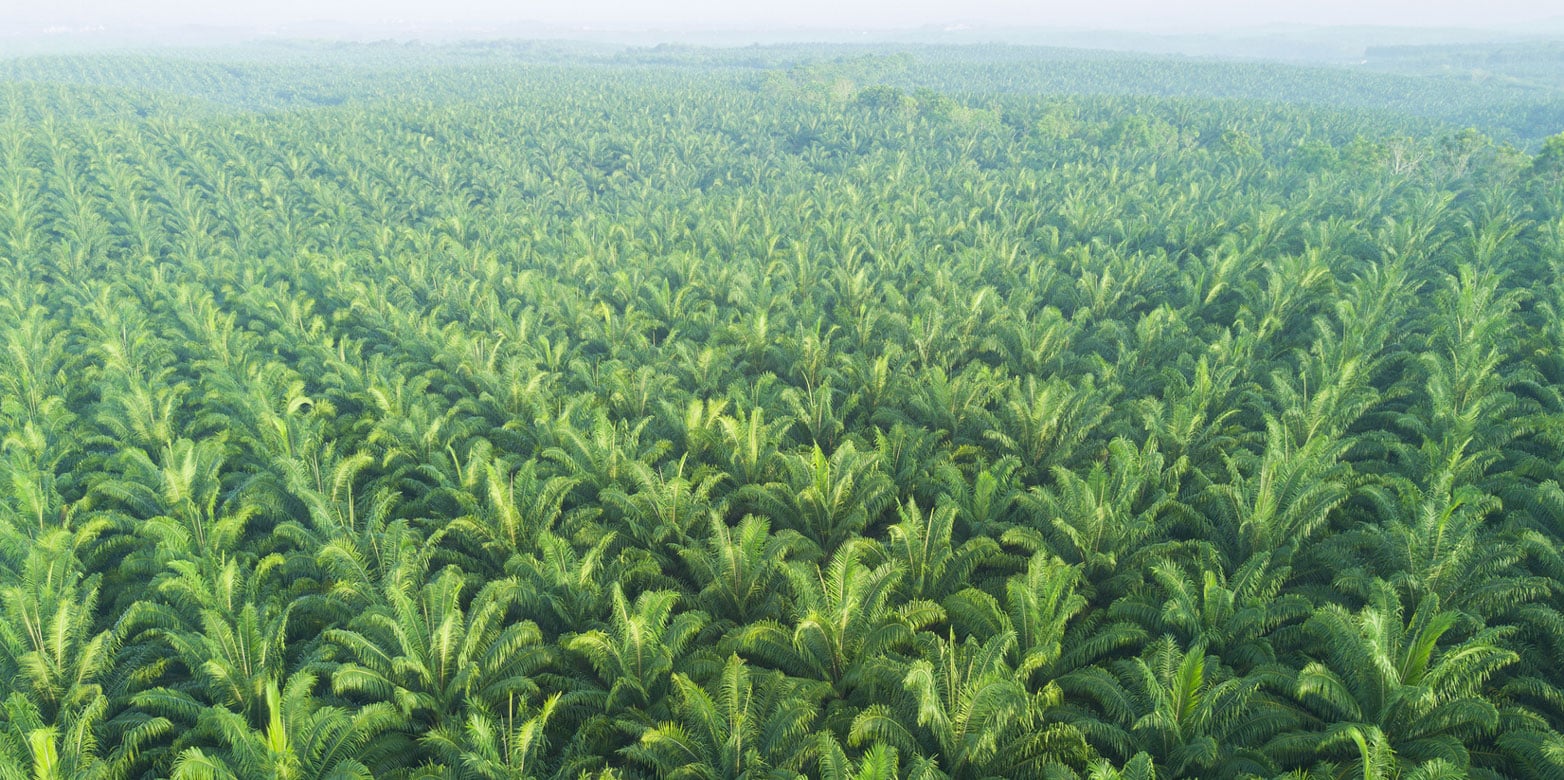
Updated 18.12.2023
What do you see? Green? Beautiful? Natural? Healthy? Biodiverse? A palm oil monoculture plantation is highly productive, and also highly damaging to biodiversity. It is only possible in tropical zones, naturally home to rainforests or wetlands. Replacing a rainforest or wetland with a palm plantation is an unmitigated disaster. But what if deforestation happened long ago to make a pasture, and the palm plantation replaced cows, significantly lowering the climate impact? A short-term improvement, or a long-term degradation? And regardless of the impact of a single plantation, increasing demand in a large global commodity market ultimately leads to more supply, and more aggregate pressure on biodiversity.
Biodiversity is highly complex, and first impressions are most often wrong.
Why is biodiversity important?
Humans cannot survive without functioning ecosystems, and have not yet succeeded in artificially designing and building one, even for a handful of humans. Our most ambitious project to date, Biosphere 2, was built using the best science available and almost unlimited resources; still it failed spectacularly and in multiple ways.
Specifically, genetic and functional biodiversity is the basis for our provisioning, such as food, clean water and air, medicine (accounting for half of all medicine used, and three quarters of discoveries), and bio-materials like wood or cotton; regulation, for example stable climate, flood control, ecosystem stability, or disease control; supporting life, including habitat formation and nutrient cycling (how does compost become new food?); and the basis for our culture, including meaning, traditions, identity, language, beauty, and much more.
Trying to place a monetary value on nature is misleading, as no amount of money will help humans survive if ecosystems are seriously degraded. Ecosystems are not substitutable: more trees cannot replace the loss of coral reefs. If our society cannot respect the ecological constraints without pricing nature, it is the economy, including market governance, that needs to change, not ecosystems.
What is the state of biodiversity today?
As might be expected given the complexity, there are many indicators of biodiversity. Let me highlight two here, starting with the Living Planet Index, described in the WWF Living Planet Report 2022, published every two years, an essential reading for anyone interested in the topic. This index represents the number of individual vertebrates (mammals, birds, fish, reptiles, amphibians) in 31’821 populations of 5’230 species, indicating a decline of 69% over 48 years (1970-2018). To make this clear, it means that over two-thirds of observed large animals disappeared worldwide in just half a century.
The second measure, the Biodiversity Intactness Index (BII) shows how undisturbed ecosystems are. Intact ecosystems are rated 100%; degradation to around 30% leads to a risk of rapid collapse. This corresponds to orange and yellow zones on the map above, and includes much of the Amazon.
International and local action for biodiversity
One year ago, at the UN Biodiversity Conference (COP 15) in Montreal, 188 countries adopted the “Kunming-Montreal Global Biodiversity Framework”, agreeing to stop and reverse biodiversity loss, including protecting 30% of land area, and 30% of degraded ecosystems, with focus on ecosystem functions and services, ecological integrity and connectivity – all while protecting indigenous communities, and financing action in poor countries.
Given the ongoing loss of natural life at rates unseen since the end of dinosaurs, and clearly representing the beginning of the sixth mass extinction, protecting 30% of ecosystems is clearly insufficient, but still a major step forward.
How are we collectively doing? While there are big differences between countries, the short answer is overall not nearly enough.
Terrestrial protected areas in Europe range from 7% to 56% per country, with an average of 26%, with nine countries already reaching the minimum required 30%: Bulgaria, Croatia, Cyprus, Germany, Greece, Luxembourg, Poland, Slovakia and Slovenia, as of the end of 2021.
Biodiversity in Switzerland
Contrary to popular imagination and postcards showing beautiful landscapes, biodiversity in Switzerland is seriously threatened, mainly due to urban sprawl, intensive land and water use, invasive species, and pesticide and nitrogen pollution from agriculture. The level of protection is critically low, with only around 10% protected, a third of the 2030 goal. Officially, 13.4% of the territory are areas “designated for biodiversity”, but not necessarily protected.
The Swiss Federal Office for the Environment FOEN provides an excellent summary of the state of Swiss biodiversity: “Switzerland’s biodiversity is under pressure. Although incentive measures are having an effect locally, biodiversity remains in a poor state and continues to decline. A third of all species and half of all types of habitat in Switzerland are threatened. Occasional gains are not enough to make up for the losses caused mainly by a lack of land area, soil sealing, fragmentation, intensive use, and nitrogen and pesticide inputs. Subsidies that harm biodiversity exacerbate this negative trend. There is an urgent need for resolute action to preserve the services that biodiversity provides. Rich and resilient biodiversity also helps to mitigate climate change and its consequences.”
Unfortunately, despite efforts by scientists, the federal administration, many individuals and organizations, and even the Federal Council, a majority of Swiss politicians see biodiversity protection as a cost and possible limitation of money-making opportunities. This is not only a reflection of individual bad politicians failing to ensure wellbeing within planetary boundaries, or the protection of the environment defined in the Swiss constitution; fundamentally there is no reason for today’s political practice of “balancing interests” to deliver an optimal outcome.
The Swiss parliament just rejected, for the second time, the government’s counterproposal for better protection. Therefore the biodiversity initiative will be voted on in 2024. Let’s hope and act for the best, but Swiss direct democracy does not have a stellar track record of placing life ahead of money.
The way forward
Systems theory identifies leverage points to change a system, with mindset and system goal near the top. Biodiversity will only be safe when it becomes the basis of how most people see the world, and the main goal of humanity, approaching Brundtland report’s “development that meets the needs of the present without compromising the ability of future generations to meet their own needs” – meeting both today’s and future needs is entirely based on healthy ecosystems.
To answer the title question, paying for biodiversity is not a financial decision comparing risk and return, rather a fundamental moral and survival goal of ensuring that humanity operates within ecological constraints, using all suitable governance mechanisms.
While working towards this goal, many smaller actions are helpful. For example the project I am co-leading with Prof. Antoine Guisan aims to identify principles and best practices of simultaneously building solar and wind electricity production and reducing pressure on biodiversity: Towards new renewable energy developments in Switzerland that preserve biodiversity.
What can you do? If you work for a company, think of the impact on human and non-human life of both corporate strategy and daily decisions.
At the individual level, other than voting for the biodiversity initiative, and for better politicians, the single biggest individual action is adapting one’s diet, towards the EAT-Lancet Planetary Health Diet. This will also directly improve your health.
And most importantly, start reflecting on what makes your life worth living. If your first thought is money, please think again.

Dr. Sascha Nick
Business School Professor
Dr. Sascha NICK, BSL Professor
